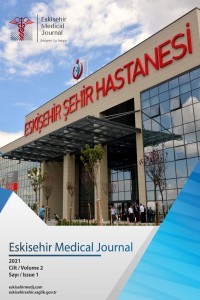Vücut Yağ Oranının Kemoterapiye Bağlı Bulantı-Kusma Üzerine Etkisi
Bulantı, Kusma, Kemoterapi, Vücut yağ oranı, Beden kütle indeksi
The Effect Of Body Fat Ratio On Chemotherapy-Induced Nause-Vomiting
Nausea Vomiting, Chemotherapy, Body fat ratio, Body surface area, Body mass index,
___
- 1. Sung H, Ferlay J, Siegel RL, et al. Global Cancer Statistics 2020: GLOBOCAN Estimates of Incidence and Mortality Worldwide for 36 Cancers in 185 Countries. CA: a cancer journal for clinicians. 2021;71(3):209-249. doi:10.3322/CAAC.21660
- 2. Crawford S. Is it time for a new paradigm for systemic cancer treatment? Lessons from a century of cancer chemotherapy. Frontiers in Pharmacology. 2013;4 JUN. doi:10.3389/fphar.2013.00068
- 3. Hesketh PJ, Kris MG, Basch E, et al. Antiemetics: ASCO Guideline Update. Journal of clinical oncology : official journal of the American Society of Clinical Oncology. 2020;38(24):2782-2797. doi:10.1200/JCO.20.01296
- 4. Gupta K, Walton R, Kataria SP. Chemotherapy-Induced Nausea and Vomiting: Pathogenesis, Recommendations, and New Trends. Cancer treatment and research communications. 2021;26. doi:10.1016/J.CTARC.2020.100278
- 5. Yokoe T, Hayashida T, Nagayama A, et al. Effectiveness of Antiemetic Regimens for Highly Emetogenic Chemotherapy-Induced Nausea and Vomiting: A Systematic Review and Network Meta-Analysis. The oncologist. 2019;24(6):e347-e357. doi:10.1634/THEONCOLOGIST.2018-0140
- 6. Portugal RD. Obesity and dose individualization in cancer chemotherapy: The role of body surface area and body mass index. Medical Hypotheses. 2005;65(4):748-751. doi:10.1016/j.mehy.2005.04.023
- 7. Siri WE, Lukaski HC. Body composition from fluid spaces and density: Analysis of methods ... Prospective Overview. In: Nutrition. Vol 9. ; 1993:224-244.
- 8. Haapala I, Hirvonen A, Niskanen L, et al. Anthropometry, bioelectrical impedance and dual-energy X-ray absorptiometry in the assessment of body composition in elderly Finnish women. Clinical Physiology and Functional Imaging. 2002;22(6):383-391. doi:10.1046/j.1475-097X.2002.00447.x
- 9. Jaffrin MY, Morel H. Body fluid volumes measurements by impedance: A review of bioimpedance spectroscopy (BIS) and bioimpedance analysis (BIA) methods. Medical Engineering and Physics. 2008;30(10):1257-1269. doi:10.1016/j.medengphy.2008.06.009
- 10. Deurenberg P, Weststrate JA, Hautvast JGAJ. Changes in fat-free mass during weight loss measured by bioelectrical impedance and by densitometry. American Journal of Clinical Nutrition. 1989;49(1):33-36. doi:10.1093/ajcn/49.1.33
- 11. Hanley MJ, Abernethy DR, Greenblatt DJ. Effect of obesity on the pharmacokinetics of drugs in humans. Clinical pharmacokinetics. 2010;49(2):71-87. doi:10.2165/11318100-000000000-00000
- 12. Prado CMM, Baracos VE, McCargar LJ, et al. Body composition as an independent determinant of 5-fluorouracil-based chemotherapy toxicity. Clinical Cancer Research. 2007;13(11):3264-3268. doi:10.1158/1078-0432.CCR-06-3067
- 13. DEMİR H, BEYPINAR İ, BAYKARA M. The Effect of the Prognostic Nutritional Index on Chemoradiotherapy Response in Lung Cancer. Journal of Oncological Sciences. 2020;6(2):96-102. doi:10.37047/jos.2020-75476
- 14. Schwartz J, Toste B, Dizon DS. Chemotherapy toxicity in gynecologic cancer patients with a body surface area (BSA) > 2 m2. Gynecologic Oncology. 2009;114(1):53-56. doi:10.1016/j.ygyno.2009.03.010
- 15. Abdah-Bortnyak R, Tsalic M, Haim N. Actual Body Weight for Determining Doses of Chemotherapy in Obese Cancer Patients: Evaluation of Treatment Tolerability. Medical Oncology. 2003;20(4):363-367. doi:10.1385/MO:20:4:363
- 16. Raman R, Mott SL, Schroeder MC, Phadke S, el Masri J, Thomas A. Effect of Body Mass Index- and Actual Weight-Based Neoadjuvant Chemotherapy Doses on Pathologic Complete Response in Operable Breast Cancer. Clinical breast cancer. 2016;16(6):480-486. doi:10.1016/J.CLBC.2016.06.008
- 17. Budman DR, Berry DA, Cirrincione CT, et al. Dose and dose intensity as determinants of outcome in the adjuvant treatment of breast cancer. Journal of the National Cancer Institute. 1998;90(16):1205-1211. doi:10.1093/jnci/90.16.1205
- 18. Lyman GH. Chemotherapy dose intensity and quality cancer care. Oncology (Williston Park, NY). 2006;20(14 Suppl 9):16-25.
- 19. Farker K, Merkel U, Wedding U, Hippius M, Höffken K, Hoffmann A. Chronomodulated chemotherapy with oxaliplatin, 5-FU and sodium folinate in metastatic gastrointestinal cancer patients: Analysis of non-hematological toxicity and patient characteristics in a pilot investigation. International Journal of Clinical Pharmacology and Therapeutics. 2006;44(1):31-37. doi:10.5414/cpp44031
- 20. Mosa ASM, Mosharraf Hossain A, Lavoie BJ, Yoo I. Patient-Related Risk Factors for Chemotherapy-Induced Nausea and Vomiting: A Systematic Review. Frontiers in pharmacology. 2020;11. doi:10.3389/FPHAR.2020.00329
- ISSN: 2718-0948
- Yayın Aralığı: Yılda 3 Sayı
- Başlangıç: 2020
- Yayıncı: Eskişehir Şehir Hastanesi
Is there a covid-19 transmission with percutaneous needle prick? A case report
Murat DUYAN, Serhat GÜNLÜ, Ali SARIDAŞ, Resmiye Nur OKUDAN
COVID-19 pnömonisinde spontan pnömotoraks ve pnömomediastinum
Atilla PEKÇOLAKLAR, Hasan Oğuz KAPICIBAŞI
İbrahim Alper YAVUZ, Onur GÖK, Utku GÜRHAN, Fuad ÖKEN
Berrin YALINBAŞ KAYA, Yonca YILMAZ ÜRÜN, İsmail YENİLMEZ, Yeliz MERT KANTAR, Ali TÜREYEN, Hatice HAMARAT, Zeynep IRMAK KAYA, Serdar EFE, Cansu DEMİRAL, Pamir ÇERÇİ, Muslih ÜRÜN
Tıbbi Terminolojide Yunan Mitolojisinin Ayak İzleri
Özlem ÖZKALE YAVUZ, Koray HEKİMOGLU, Mehmet COSKUN, Gaye ULUBAY, M. Şule AKÇAY, Alev DOLU, A. Muhtesem AGILDERE
Nadir Bir Koroner Arter Çıkış Anomalisi: İkiz Circumflex Arter
Cihan ÖZTÜRK, Melik DEMİR, Burcu ÇAKIR, Kenan YALTA
Mine TEPETAŞ, Alaettin ÜNSAL, Ahmet AY, Sevda SUNGUR, Didem ARSLANTAŞ, Halime KÜÇÜK
Nadir Bir Olgu Olarak Bilateral Hızlı Yıkıcı Kalça Osteoartriti
Ajda BAL, Özgür Zeliha KARAAHMET, Yasemin TOMBAK, Cüneyt YÜCESOY, Deniz DÜLGEROĞLU ERDOĞAN, Ece ÜNLÜ AKYÜZ
Ayhan KÜP, Mehmet ÇELİK, Şeyhmus KÜLAHÇIOĞLU, Abdulkadi USLU, Mert EVLICE, Mehmet Muhsin TÜRKMEN, Ramazan KARGIN
